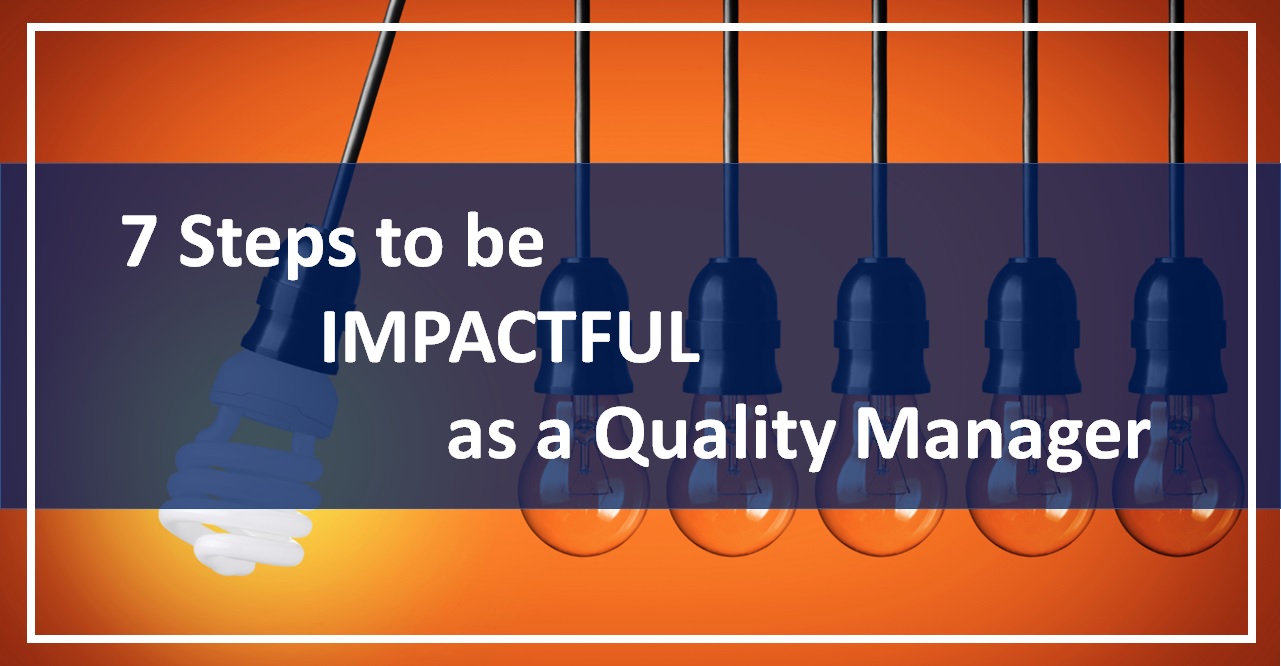Introduction how manager can solve the problem
Do you have a feeling you are managing quality for your organization just for compliance reasons, just to have a certificate on the wall? This happens in many organizations. What people fail to see is that  real, impactful quality management has a strong, positive effect on the company and on its financial results! But how do you as a manager solve the problem and create that level of impact in your company as a quality manager? Too often you are bogged down by the day to day issues you are facing with customer complaints, blocked stock, external audits and just managing the complexity of all the items in your quality and food safety management system.
real, impactful quality management has a strong, positive effect on the company and on its financial results! But how do you as a manager solve the problem and create that level of impact in your company as a quality manager? Too often you are bogged down by the day to day issues you are facing with customer complaints, blocked stock, external audits and just managing the complexity of all the items in your quality and food safety management system.
In this article we will share seven important steps with you to step away from reactive quality management to becoming an impactful quality manager who delivers amazing results to the company. The steps in themselves will sound straightforward and simple, but it takes a lot of determination and focus to successfully deliver each step.
Ensure you have a good team
Every success is defined by the team, hence this is the place to make a start. In many companies, the quality department historically has been the place to “park” employees that did not fully perform in other departments. While this approach could be taken in the 1980’s and 1990’s, this is nowadays a dangerous route to take! In most countries around the globe there have been significant changes to legislation in relation to food manufacturing. Next to this GFSI standards like BRC, IFS, FSSC 22000 and SQF have been established since. Over the years the GFSI standards have been a major driving force in the elevation of quality and food safety management in terms of thoroughness and complexity. In other word
s: quality management in the food
manufacturing industry has become a true discipline.
 How can you as a quality manager solve the problem? For this reason it is important to ensure you have a capable and strong enough team. A good way to assess this is to get insight in the strengths and weaknesses of your team in terms of knowledge and skills to work with other people (influence them). Next to this it is also good to have a good view of the overall workload of your team as the level of the standards has risen sharply over the last 5-10 years, whereas most of the time the number of people in your team hasn’t. Hence you might be facing a work-overload situation that needs to be address first.
How can you as a quality manager solve the problem? For this reason it is important to ensure you have a capable and strong enough team. A good way to assess this is to get insight in the strengths and weaknesses of your team in terms of knowledge and skills to work with other people (influence them). Next to this it is also good to have a good view of the overall workload of your team as the level of the standards has risen sharply over the last 5-10 years, whereas most of the time the number of people in your team hasn’t. Hence you might be facing a work-overload situation that needs to be address first.
Before you continue to the execution phases of your plans (see later on) you must ensure to take action if there are true non-performers in your team. It is OK to recognize that not everybody is at the desired level yet – you can get them there over the coming years. As long as you create the focus and continue to invest in people’s skills and competencies you will be able to build a strong and high performing team.
Get insight with CONQ
Once you know the strengths and weaknesses of your team it is time to start doing the same for the quality performance of your organization. The best way to do this is to get good insight in your cost of non-quality (CONQ). Now I hear you ask: “ Why is cost of non-quality so important?” The biggest reason why CONQ is so important is that it is expressed in money – and money is the universal language all managers and company owners understand. If you need to connive you manager to invest in your team and to invest in quality in general , you need to be able to substantiate the benefits. And this is always done in money!
 Most quality systems deliver only a partial insight of the total CONQ a company is facing. By working with the production and finance department and setting up a systematic process where you use typical standard costs for e.g. complaints, not right first time product, returned goods, degrade product, scrapped product etc., you will be able to set-up a system to easily (and quite accurately) track your company’s CONQ performance. Most of the time you can even use the same approach to create a historical overview of the past three years for the CONQ your company has been facing.
Most quality systems deliver only a partial insight of the total CONQ a company is facing. By working with the production and finance department and setting up a systematic process where you use typical standard costs for e.g. complaints, not right first time product, returned goods, degrade product, scrapped product etc., you will be able to set-up a system to easily (and quite accurately) track your company’s CONQ performance. Most of the time you can even use the same approach to create a historical overview of the past three years for the CONQ your company has been facing.
The numbers might be higher than you expect, but this is good news! It means there is a lot of room for improvement. Next to this there is another benefit of CONQ: most of the components have a direct impact on the company profit as almost every item in CONQ is and additional costs that can be avoided and if it is structurally avoided you will have a structural increase of the company’s profit. Now you have the attention of your senior management and company owner.
Create awareness / sense of urgency and how manager can solve the problem
Once you know you have a good team or at least are building towards it and you have good insight in your cost of non-quality it is time to ensure you grab the full attention of your senior management and/or company owner. The work you have done in relation to your team (e.g. workload analysis) and in getting good (historical) insight in your CONQ are two important factors of a presentation you want to prepare for your senior management.
In the presentation you want to show that quality and food safety and nowadays really crucial factors for any successful company. On the one hand you can do this by showing the impact of not managing quality and food safety correctly by taking examples of other companies (preferably from your type of industry) who have faced severe issues in the market because of quality problems. Next to this you also want to make clear that the regulatory landscape and certification requirements are continuously changing and ever increasing the demands on your company.
There is one more items you should consider to bring into your presentation: a comparison between the impact of a safety related fatality in your company and a food safety related fatality of a consumer of your products. As you will find out (just by looking at the newspapers) a food safety related fatality can be detrimental for company and in some cases even cause bankruptcy. This hardly ever happens in the case of a safety related fatality, which is of course a tragedy, but it will not threaten the continuity of a company.
How can a quality manager solve the problem? If you want to have a good example of this type of presentation go to our website – we have posted an example presentation there, which you can even download for free.
Together, define a multi-year plan
Once you get your senior management and company owner agree that quality and food safety are a priority to really work on it is time for you to define a multi-year plan. In defining your plan there are two things really important: first of all of course the content of your plan – you want to pay attention to the right things in the right order. But be aware do not jump immediately into the content all by yourself (or only with a few direct reports)! A good plan is only a good plan if you have enough believers in your plan, even more the plan should never be YOUR plan it must be a plan which is owned by a much larger group of people. You can start to make a first draft yourself or with a small team, so at least you know where you would like to take quality and food safety towards in the coming years. But leave it a that – a draft! This brings us to the second and most important part of your multi-year plan: make it together with the relevant people. There are two key stakeholder groups that you need to work with: your senior management and your team.
 First of all you want to float your ideas to your senior management and company owner to ensure they are aligned with you and are able to give their input up front. This is best done by setting up one-on-one meetings with each of them and prepare the agenda so they know you want to talk about your multi-year improvement plans. Instead of explaining the draft plan to them, let them do the talking – you want to understand what aspects are important for them. Only explain your draft at the end of the discussion. Quite often you will find the general direction will be the same, but by playing it this way you might get additional insights and of course more buy-in because the senior manager has been able to express his/her ideas.
First of all you want to float your ideas to your senior management and company owner to ensure they are aligned with you and are able to give their input up front. This is best done by setting up one-on-one meetings with each of them and prepare the agenda so they know you want to talk about your multi-year improvement plans. Instead of explaining the draft plan to them, let them do the talking – you want to understand what aspects are important for them. Only explain your draft at the end of the discussion. Quite often you will find the general direction will be the same, but by playing it this way you might get additional insights and of course more buy-in because the senior manager has been able to express his/her ideas.
How can a quality manager solve the problem? Now it is time to work with your team – and here you take exactly the same approach: you want to build you multi-year plan together with your team. You can do this be taking them on the same route you have gone so far: show them the outcomes of the assessment of your department, the results of the cost of non-quality analysis, the presentation you have held for your senior management and then facilitate a team discussion towards a multi-year plan. Be aware not to present your plan – build it from scratch with your team. This way your team will really own it – yes the wording might be slightly different and some of the priorities might also be different. It does not matter – you only want to push your thoughts on topics or priorities that REALLY matter. By doing it this way you will generate tremendous ownership in your team of your (the group’s) plan. The last thing you want to be facing is a team who see the plan as the boss’ idea.
Create focussed improvement (CAPA)
One of the biggest mistakes quality managers make is not to set priorities in all the improvement actions they feel that need to take place. The majority of food producing companies are working against one or more GFSI certification schemes. In the requirements for these certification schemes usually there is a list of situations where performing a root cause analysis and setting up corrective and preventive measures is mandatory (e.g. food safety related complains, CCP breaches, external audit findings, etc.). In quite a few quality management systems this has been translated to: “ we will perform a root cause analysis followed by corrective and preventive actions for every issue we encounter”. This is not manageable, takes a lot of time and leads to shallow improvements and usually little or no results. How can a quality manager solve the problem?
preventive measures is mandatory (e.g. food safety related complains, CCP breaches, external audit findings, etc.). In quite a few quality management systems this has been translated to: “ we will perform a root cause analysis followed by corrective and preventive actions for every issue we encounter”. This is not manageable, takes a lot of time and leads to shallow improvements and usually little or no results. How can a quality manager solve the problem?
Here’s what you really want to do: yes – you must perform a root cause analysis on those topics that are mandatory in relation to your certification scheme. There might be even some areas in addition to this that are mandatory because of legislation in your country. But for the rest, you want to take a different approach! Make a historical overview of the last (two) year(s) of all the issues you have been facing (not first time right product, blocked products, complaints, issues and recalls) and from this create a Pareto chart. All of this information will already be available as part of the CONQ analysis. Once you have the Pareto chart you can see what topic gives you the biggest monetary loss – this is the area you want to place your improvement efforts on.
The strong point of taking this approach is that you focus all your effort on creating the maximum result. And when results get in people (including senior management) will see that your plan is working! This is a very powerful fly-wheel that will only make you and others drive for more.
Issue management and how manager can solve the problem
Despite all the good things you are doing as part of your quality management approach and the multi-year plan you still might face issues. Issues like repeating complaints, more severe complaints (e.g. food safety related) or complaints with your biggest customers. In addition (and not contradiction) to the previous section you must place focus on these as well. You really want to pro-actively manage issues when they occur, this way you have the highest likelihood to keep costs low and customers and equally important your internal stakeholders happy.
 If you fail to manage issues correctly it will only impede the execution of your multi-year plan and give reasons for senior management to start doubting your plans or even your capabilities. So next to focussing on one big topic to really improve you MUST manage all issues at hand with priority. How a manager can solve the problem? Make sure you plan for this. Leave at least 1 hour per day available for yourself to manage severe issues. Of course this is too little a time reservation when an issue really occurs, but it does two things: the first hour you have available any way so you don’t lose out on other things and if there is no issue you can use that hour to work on the big improvement (so you will move forward faster than planned if there are not a lot of issues). Don’t spend the hour on reading emails or sitting in meetings etc.!
If you fail to manage issues correctly it will only impede the execution of your multi-year plan and give reasons for senior management to start doubting your plans or even your capabilities. So next to focussing on one big topic to really improve you MUST manage all issues at hand with priority. How a manager can solve the problem? Make sure you plan for this. Leave at least 1 hour per day available for yourself to manage severe issues. Of course this is too little a time reservation when an issue really occurs, but it does two things: the first hour you have available any way so you don’t lose out on other things and if there is no issue you can use that hour to work on the big improvement (so you will move forward faster than planned if there are not a lot of issues). Don’t spend the hour on reading emails or sitting in meetings etc.!
When managing issues there is one more important thing – defining appropriate actions and following up on all actions. You might easily lose your overview if there are several issues at hand at the same time. Hence good action tracking is important. Have a look at our blog on Inspection Rounds as it contains a link to a powerful action tracking tool in Excel, which is free for you to download.
Celebrate all successes
Next to the fly-wheel factor we described in the section on defining your multi-year plan together, there is a second equally powerful fly wheel: celebrating your success. Quite often managers have a tendency only to review performance and celebrate the success once a year. This is way too infrequent! You really want to take the opportunity and celebrate every success, no matter how small it is.
Why? Celebrating success  is not about bragging – it is about showing recognition to those people involved in creating the success. Celebration does not necessarily mean you are going to eat cake / give (financial) incentives to people. Of course you should do this from time to time (certainly when you have big successes). You also want to share the smaller successes and give recognition to the people who created these successes. You can even link this to a nice competition e.g. “Employee of the Month” or “ Improvement Guru of the Month” and give a perk like the front parking spot for the coming month. This way you can easily create recognition for everybody as you will not only communicate the winner be all contestants achievements.
is not about bragging – it is about showing recognition to those people involved in creating the success. Celebration does not necessarily mean you are going to eat cake / give (financial) incentives to people. Of course you should do this from time to time (certainly when you have big successes). You also want to share the smaller successes and give recognition to the people who created these successes. You can even link this to a nice competition e.g. “Employee of the Month” or “ Improvement Guru of the Month” and give a perk like the front parking spot for the coming month. This way you can easily create recognition for everybody as you will not only communicate the winner be all contestants achievements.
If celebrating success is not (yet) part of your company’s culture, make a start as it is not only a fly wheel, but also a crucial enabler of the overall success of your approach. It is the fuel your multi-year plan will work on, because 90% of any success is defined by the motivation and ownership of the people who have to deliver it!
¿Quieres tener el mejor apoyo de la historia?
Como profesional de la calidad y la seguridad alimentaria, siempre tiene momentos en los que piensa: "Me gustaría discutir esto con un experto". O se pregunta ¿cuál es la mejor manera de abordar un problema difícil? y le gustaría discutirlo con una persona con experiencia.
El QFS Success Coaching de Food Safety Experts le da acceso ilimitado a nuestros expertos durante un año, cuando lo necesite.
¿Le interesa? Haga clic aquí ¡! O consulte : https://foodsafety-university.thinkific.com/courses/qfs-success-coaching
Otros programas interesantes de Expertos en Seguridad Alimentaria:
Other Interesting Articles of Food Safety Experts
What skills Does a Quality Manager Need?
La persona de control de calidad adecuada
El reto de alcanzar tus objetivos

